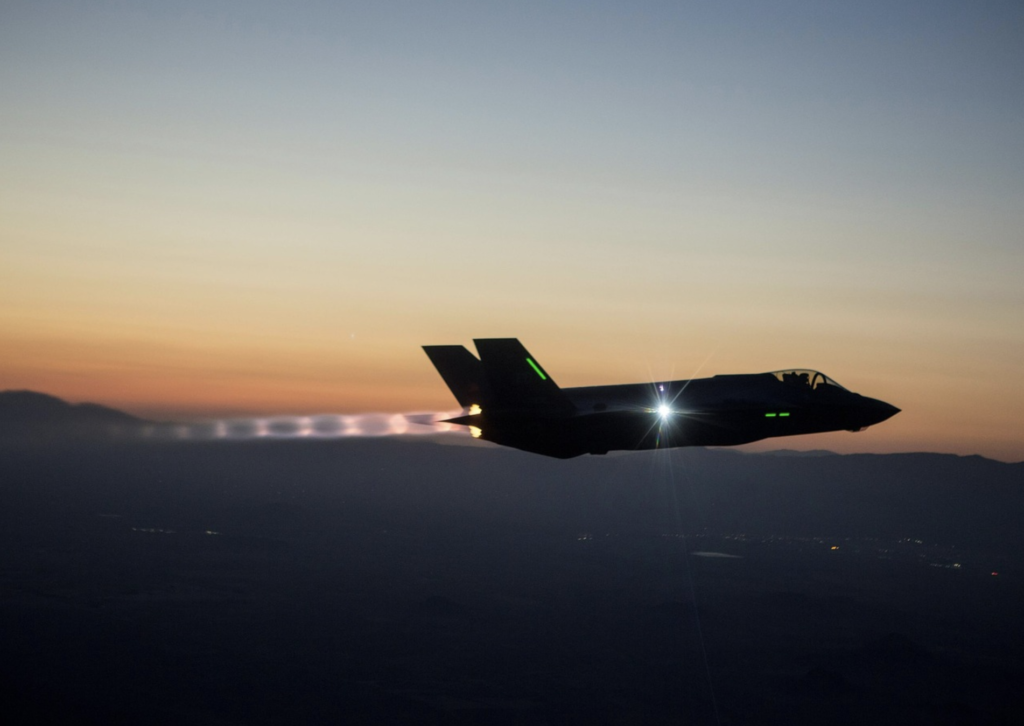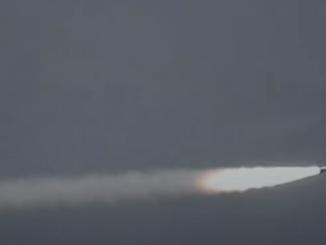
Stealth can simply be defined as the ability to hide from the enemy. From combat aviation perspective, stealth aircraft are designed to possess extremely low observability in terms of radar cross section (RCS), infrared signature (IRS) and visual identification, which helps in avoiding detection by enemy’s active and passive sensors. Historically, only United States has successfully operationalized combat aircrafts with inherent stealth features. From F-117 Nighthawk to B-2 Spirit, and from F-22 Raptor to F-35 Lightening, United States has proved its pioneer capability to develop, employ, sustain, utilize and even evolve stealth aircrafts with respect to the variability of the threat environment. In fact, stealth is being regarded by many as the trademark for distinguishing a true 5th generation fighter aircraft from older 4th generation examples. This primary characteristic feature, exclusive to stealth airframes only, henceforth grants four major advantages over legacy designs.
First; stealth offers enhanced survivability as the probability of the stealth aircrafts getting tracked and intercepted by enemy forces is far less in comparison with legacy aircrafts. In the majority of cases, stealth aircrafts – due to added superior situation awareness – can eliminate the target before getting exposed to the threat. Second; stealth is key in achieving the element of surprise which allows successful exploitation of enemy vulnerabilities. In air combat particularly, this advantage provides look first shoot first capability which is of pivotal value in the establishment of air space denial for antagonist forces. Third; stealth allows the expansion of combat air space as stealth aircraft can penetrate well defended air space which is believed too risky for non-stealth aircrafts. In general, stealth fighters are considered ideal as path makers since they can neutralize the enemy’s pivotal node points pre-emptively and make operational utilization of other aircraft possible within the given airspace. And finally; stealth aircraft are a considerable conventional deterrent due their unmatched operational capabilities. This prowess, specifically related to beyond visual range (BVR) combat and deep strike missions, yields psychological dominance over the adversary, which is key to thwart conflicts and maintain coercive control.
Stealth aircraft, despite all the remarkable advantages briefed above, still have a certain set of shortcomings. First, stealth is a very complex technology and no nation in the world has yet fully practicalized it with United States being the sole exception. In Global Defence market, there is only the option of F-35 Lightening available for export which is prone to US imposed operational controls. Other examples, like Russian Su-57 and Chinese J-20, are not fully combat ready. The complexities and conditions that exist in the availability of stealth aircrafts has compelled several armed forces to either abandon stealth ambitions for time being (for example France and Germany) or initiate work on domestic products in hopes to match benchmarked capabilities by spending enormous capital in terms of economics and time, e.g. Turkey’s TFX and South Korea’s KFX projects.
Second, stealth fighters are far more expensive to operate and maintain than legacy counterparts. Besides United States, no other nation in the world has the financial capacity to raise a dedicated fleet of stealth fighters, and even modern air forces with deep pockets have been forced to retain limited fleet due to higher net economic costs involved. Russia, despite of having a robust aviation industry, is struggling to finance Su-57 project, and China is still maturing the key technologies needed to achieve the standards of a true 5th generation fighter for its J-20 project. None of the NATO members have indigenous stealth fighter projects, rather several European nations have diverted the focus directly towards 6th generation programs. As a stopgap measure, majority of US allies have purchased F-35s in limited numbers to add stealth oriented capabilities without overstretching the scope of defence budgets.
Third, the stealth aircraft suffer from payload restrictions as to maintain stealth configuration weapons are meant to be carried within internal weapon bays only. Although stealth fighter aircraft can carry payloads on external hardpoints just like older generation aircrafts, this approach compromises the stealth configuration and defeats the purpose of fielding a stealth platform in the first place. Moreover, a wide variety of air to ground munitions are too large to fit within weapon bays. For example, F-35 cannot carry sensor fused cluster munitions, AGM-88 HARM and AGM-84 Harpoon missile internally, thus demanding compromise of stealth configuration for execution of anti-armour, SEAD/DEAD, and anti-ship warfare missions using these munitions. Similarly, air launched cruise missiles like Storm-shadow ALCM and AGM-158C LRSAM are also carried on external hardpoints; albeit the long range of weapons nullify the need of maintaining stealth. Therefore, conventional design fighters are still used as the preferable platform for strike missions in which employment of large size munitions is concerned.
The above-mentioned limitations of stealth platforms favour the utilization of non-stealth platforms. Modern versions of 4th generation aircrafts, often classified within 4.5th generation category, now incorporate several modern systems which were initially nascent to F-35 fighters only. For example, all current 4.5th gen fighters of American origin, i.e. F-15 E/EX, F-16 V/Blk70 and F/A-18 E/F, incorporate similar weapon packages as F-22 and F-35; house state of art technologies like Airborne Electronically Scanned Array (AESA) radars, sensor fusion, advance cockpit layout, enhanced human-machine adhesion; and have also sustained existential advantages related to payload, operational modularity and flight performance. As a compensation measure for the lack of stealth, 4.5th generation aircrafts undertake additional emphasis on Electronic Warfare (EW) and Electronic Counter Measures (ECM), both in the shape of built-in suite and externally mounted EW/ECM pods, to augment the mission execution capabilities within a challenging battlespace. The same approach can be observed in European modern fighter aircraft including latest versions of Dassault Rafale, Eurofighter Typhoon and Saab Gripen.
Stealth fighters have exceptional beyond visual range (BVR) capabilities but are vulnerable in within visual range (WVR) combat. In contrast, modern 4.5th generation fighters of Western origin present promising BVR capabilities and credible WVR prowess due to better flight characteristics. Therefore, nations which do not have strategic depth and face geographical proximity with the enemy primarily rely on advanced 4th generation fighters for fulfilling their strategic demands. Similarly, modern combat aviation is now based upon power projection of combined assets, not just fighter aircrafts. Alongside fighter aircrafts, the modern combat involves the usage of force multipliers like AEWCS and ELINT assets, unmanned systems, multi-mode satellites, and even land/sea-based systems within a network centric environment to paint a complete picture of the battlespace. This comprehensive network of systems, when working together, ensures the achievement of requisite objectives while minimizing risks as much as possible. Henceforth, it can be argued that stealth aircrafts on their own are not a true game changer. It is the extent and capacity of network centricity of military assets which is the difference maker.
The deployment of a high-end asset like F-35 has allowed several air forces to reduce the size of fighter aircraft fleet and increase combat net-capabilities at the same time. However, unlike USAF which is structuring its combat arm around F-35A, the allied nations also continue to rely upon evolved variants of 4th generation aircrafts to constitute the bulk of combat fleet. There are major NATO states which have decided to solely maintain the proven designs instead of procuring off-the-shelf stealth platforms from US, e.g. air forces of both Germany and France have side-lined F-35 from their modernization programs. Even the United States Navy (USN) itself retains a mixed operational fleet of F/A-18 Super Hornets and F-35 Lightening for carrier borne operations. This mixture of stealth and non-stealth platforms vindicates the approach of overcoming limitations of stealth fighters using non-stealth designs, and vice versa.
The above argumentation summarizes the rationale why stealth fighters presently do not have the potential to act as a discrete replacement of the legacy design fighters on a universal scale. It also proves that the presence or absence of stealth design should not be used as a primary criterion for tagging certain combat aerial systems as modern or obsolete. In fact, for majority of nations, stealth fighters are exclusive assets needed in limited numbers to undertake tasks beyond the capacity of older generation aircraft. However, the combat proven designs, i.e. 4.5th generation fighters, due to economic feasibility, high-end flight performance parameters, myriad operational modularity and superior payload characteristics, can still accomplish numerous combat challenges better than stealth aircraft. Therefore, in the contemporary threat environment, the stealth and non-stealth aircraft will continue to co-exist, and will continue to offer combat solutions with respect to the variability of threat perception and strategic requirements of air combat forces around the globe.
![]()




Be the first to comment